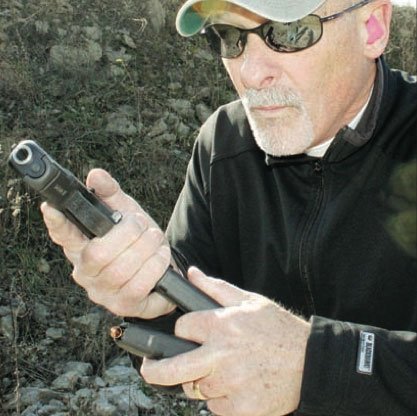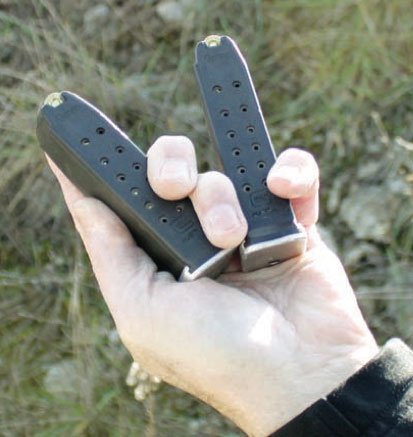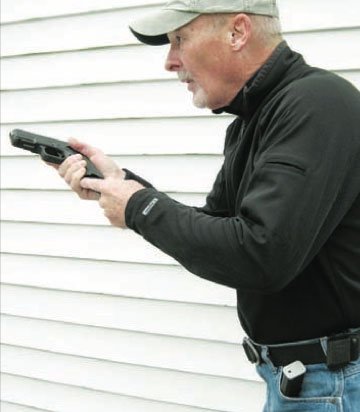The tactical reload is taught to be executed when there is a “lull” in the gunfight. The question is: when will that be?

Sometimes, it might be obvious that your assailant is down after an exchange of gunfire and you have no reason to believe there are others involved. This would be a good time to reload in the event your attacker rises up and starts to fight again. But, short of actually having your opponent in your field of view, can you ever be assured of how long this lull will last? Maybe it’s not a “lull” at all, but a flanking maneuver which will soon place you in your opponent’s sights. If I could offer you some telltale signs of what a lull in the action will be, I would do so; however, I don’t know what they are short of visual confirmation. I’m not sure anyone does.
Is This Worth Teaching?
With this in mind, should instructors spend valuable time teaching a tactical reload? Is it a valid technique or just something to teach to fill up training time? The idea of being able to retain valuable ammo sounds like a good one since no one can predict how much will be needed to end a fight. Statistics accumulated over decades of research reveal that most conflicts (non-battlefield) are over rather quickly with just a few rounds fired, but no research guarantees this. The one thing I will guarantee is that Mr. Murphy is alive and well and he will visit you when you least need his involvement. Training to statistics is just not something I would advise, but that is up to you. My thought on tactical reloads is that they should be taught, but not a great deal of valuable instruction/training time should be used. In a fight, when in doubt, there is no doubt – DON’T! If you don’t know how much time you have, reload as fast as possible – time is life in a gunfight.
Various Techniques
Over the last few decades, several techniques to retain partially loaded magazines have been developed and I attribute them to particular schools. I call them the Gunsite Technique, the Thunder Ranch Technique and the Mid-South Technique, respectively. In addition, I will include one I simply call the “Kneel-Down” as it is descriptive of the physical action taken. The Gunsite Technique is part of the Modern Technique of the Pistol, as it is still taught at the famed Gunsite Academy. To use, the shooter acquires the spare magazine as if they are going to perform a speed load, but, instead of jettisoning the magazine in the gun, the support hand is placed below the grip and the magazine is dropped into the hand with the ring and pinky fingers capturing it. The magazine is pulled from the grip and the hand rotated until the loaded magazine is below the magazine well and is then inserted.

This technique was created when the only double stack magazines came from either a Browning Hi-Power or a Smith & Wesson Model 59 and the majority of pistol shooters were using some type of single column magazine. Trying to capture a GLOCK magazine with its thick plastic housing can be problematic when using the ring and pinky fingers, but it can be done. That said, many find it easier to use the Thunder Ranch Technique when using a double stack magazine. Invented by Clint Smith, this technique uses the greater tactile sense in the thumb and index fingers to secure the partially spent magazine. Like the Gunsite method, the support hand holding the reload is placed below the magazine well and the magazine ejected. It is caught between the index finger and thumb, rotated to place the reload under the grip which is now trapped between the index and middle fingers. Both techniques have been proven to work in the field and it comes down to which you prefer.
Juggling Act
Both the Gunsite and Thunder Ranch methods require two magazines to be “juggled” in the same hand. Shooters using double stack magazines and having medium to small hands might find such manipulation difficult. When I attended John Shaw’s Mid-South Institute of Self- Defense Shooting, his answer was to eject the partially spent magazine into the empty support hand which places it into a pocket and then performs a conventional speed reload. Shaw could perform this technique so quickly that it did not look like a retention technique at all. Many shooters find this faster to perform than either of the first two, while others find it to be slower. It is simpler as only one magazine is in the support hand at a time. In competition circles, this method is called a reload with retention and offers continuity with the speed reload. A technique I like since it is easy to do and requires little to learn is to kneel close to the ground and perform a conventional speed load. This places the partially spent magazine on the ground just in front of the shooter where it is easy to retrieve and allows the shooter to take low cover or just be a smaller target.
Pocket It

It is advisable to place the partially loaded magazine into a pocket separate from other fully loaded magazines with the exception of one circumstance – if it happens to be the only magazine you have! If the magazine you just saved is now the spare, it makes little sense burying it in a pocket. What if you need it? Isn’t that why you kept it?! In this situation, it makes a great deal of sense to place the magazine in the empty magazine pouch for easy access. If other magazines are available, then place the partially loaded one in a pocket. There is no reason to fiddle with this – put the magazine in your hand with the index finger tip to tip with the top round just like you would if you were trying to perform a speed reload. By doing this, you give yourself a felt index to “hook” the edge of the pocket with the index finger which acts as a guide. Once the index finger is inserted into the pocket, the magazine can then be pushed down along the palm of the hand and into the pocket. The index finger and palm will act as a funnel to slide the magazine into place.
Final Thoughts
Like all things training related, learning which of these tactical reload techniques is best for you is a journey of discovery. Learn, and then practice, each one using speed as a stressor to see which will work best for you when digital dexterity is at a premium. If you fumble around more with one than another, you probably have your answer as to which is best for you. It may even be a good idea to practice both the Gunsite or Thunder Ranch methods and the Mid-South reload with retention so you give yourself options which can come in handy in conflict.
Options are always a good thing!
About the Author: Dave Spaulding is a 34 year veteran of law enforcement and secu- rity operations. He retired with the rank of lieutenant and worked in all facets of law enforcement, including communications, corrections, patrol, court security, investigations, undercover operations, SWAT and training. He is the author of over 1,000 articles which have appeared in law enforcement and firearms publications and is the author of two best-selling books. He was named the 2010 Law Enforcement Trainer of the Year by ILEETA and Law Officer magazine.
This article is a contribution from articles and gear reviews for the patrol officer. P&SN is a valued supporter of BlueSheepdog and the Blue Crew. You can obtain a free subscription to the Police & Security News magazine by joining the Blue Crew.